A SHORT HISTORY OF THE GUERNSEY BREED
By
W. G. de L. Luff, Vice-President Royal Guernsey Agricultural
& Horticultural Society
 THE GUERNSEY STEER
THE GUERNSEY STEER
Earliest known painting in oils of a Guernsey 1841
By permission W Luff
Much has been written about the origins of Guernsey Cattle
and many claims have been made about the way in which the 'Guernsey
Breed' came to be established on a small island in the English
Channel. In fact, very little concrete evidence exists about
the cattle of Guernsey prior to the nineteenth Century and most
theories, such as one that suggests that cattle brought to the
island by monks who had been banished from Mont St. Michel in
the year 960 A.D. formed the foundation of the present breed
cannot be verified and must be regarded as conjecture or pure
fantasy.
There may be some truth in the theory that the Isigny cattle
of Normandy and the Froment du Léon breed from Brittany
were ancestral relatives of the modern Guernsey. Indeed the Jersey,
the Guernsey and the Froment du Léon are the only members
of the Channel Island sub type of European Blond cattle.
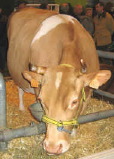  FROMENT DU LEON CATTLE
FROMENT DU LEON CATTLE
The "Froment du Léon" is a high fat producing
breed that was common to the district around the town of St.
Pol de Leon, in Brittany. It is slender, wheat-coloured, lyre-horned
and looks very like the old dun Shetland cows of the early twentieth
century. While similar in colour to the Guernsey, it is smaller
and of variable conformation. Indeed the Froment du Léon
breed society imported semen from Island Guernsey bulls some
years ago in an attempt to improve both conformation and milk
yield. Breed numbers now indicate that its current status is
'at risk'.
The large Normandy brindle took its name from the rich butter
district of Isigny. Isigny cows were heavy producers of a high
quality and fine-flavoured milk of a rich primrose colour, while
the exterior skin and interior fat carried that yellow pigment
so characteristic in the Guernsey breed. The horns curved forward
and inward similar to the Guernsey. The breed has been absorbed
into the present day Normande.
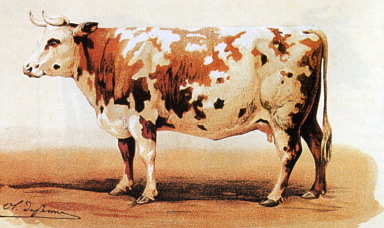 COTENTINE COW 1862
COTENTINE COW 1862
The main ancestor of the Normande
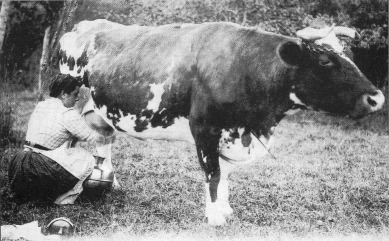 NORMANDE COW Circa 1900
NORMANDE COW Circa 1900
As far as definitely traceable ancestry is concerned no records
exist at all prior to the publication in 1878 of a privately
subscribed register of Guernsey Cattle, initiated by the Reverend
Joshua Watson of 'La Favorita" and Mr. James James of 'Les
Vauxbelets' and based on rules of selection including conformation.
This was followed in 1881 by the publication of the first volume
of the 'General Herd Book', which was based upon the principles
of American, and English herd books, that is, that entry was
allowed to animals that might be 'proved to possess the qualification
of purity of race'. Rules for entry must have been rather free
as in the preface to the General Herd Book it is stated that
'If pedigrees are short, this arises from the fact that it has
not been customary to keep a written record' and 'Stock exhibited
at island shows have not been distinguished by names till within
the last two years'. The Cattle considered to be of pure race
varied in colour including 'white, red and black in any mixture
and shade except roan, no instance of which is known to have
occurred. Brindle is not uncommon. The nose may be either white
or black'.
In 1881 it was decided to publish Volume 1 of the Herd Book
of the Royal Guernsey Agricultural and Horticultural Society,
the Committee having agreed to take over the work done on the
original 1878 and 1879 publications. For 15 years the General
Herd Book was published in competition with the R.G.A.&H.S.
Herd Book, but the latter increased in general recognition on
the island and especially in America.
But what of the history of Guernsey Cattle prior to the nineteenth
century? Generally this must have been influenced by two main
factors, the natural development of indigenous wild cattle and
economic and social pressures on the human community. It is also
worthy of note to state here that no 'breeds' of dairy cattle
are known to have existed anywhere in the world until the late
nineteenth century. Regional differences of "race"
in cattle before the eighteenth century were largely the outcome
of geographical distance or isolation by natural barriers rather
than of deliberate attempts to maintain purity of breed.
Early man discovered how to cultivate wheat and to domesticate
wild animals about 10.000 years ago in the Middle East in the
Valley of the Tigris and Euphrates and the hills of Turkey. The
cattle that were originally domesticated were the large Aurochs
which stood up to six feet at the shoulder and were noted for
their savage temperament. Cave paintings indicate that the Auroch
was variable in colour but generally brown with a darker stripe
down the back. It was from these early domestications that Bos
Longifrons soon developed and over the next millennia may have
come along with human migration from the Middle East probably
via North Africa up through Spain and into France. Alternatively
a parallel development of the Bos Longifrons type could have
occurred from domestication of Western European Cattle. The Guernsey
breed is unusual among European breeds in possessing both the
bovine haemoglobin B allele and the Beta Casein A2 allele, which
are prevalent in African and Asian cattle, indicating that the
former theory may be the most accurate. Bones of domestic cattle
have been identified in Jersey from approximately 4500 B.C. and
there is no reason to doubt that they existed on the other islands
at similarly early dates.
In Roman times the introduction of larger Italian Cattle resulted
in a cross that had something of the appearance of the Brown
Swiss breed, but with a greater variety of colours including
mouse and fawn together with black and red. Later on, when the
Norse invaders swept along the coasts of Europe and England they
brought with them small dun coloured cattle, noted for their
rich milk. These when crossed with other races resulted in cattle
of broken colour, often yellow and white, and of small size,
and these are thought to have populated the coasts of France
and the Channel Islands.
Cattle of this type probably existed in the Channel Islands until
about the middle of the 18th Century when the importation of
Dutch cattle into England started the improvement of the meat
producing British cattle. In 1756 Hale published his book 'The
Complete Body of Husbandry' in which we find the first description
of island cattle. These were 'Very like Dutch Cattle' - the influence
of cattle from Holland and Flanders had obviously reached Guernsey
as well as England and it is likely that this influence increased
the size of cattle in the island.
It appears that during the late 18th Century and up until
the end of the Napoleonic Wars, a general degeneration in local
cattle occurred due possibly to the uncertainty of the times
and the fact that a large number of Guernseymen were then in
the employ of the owners of Privateers that sailed out of the
Island, or engaged in the trading of wines, spirits and other
commodities that could enter the islands from France free of
duty and be legally re-exported to England without the imposition
of tax.
During this period large numbers of cattle were exported from
the Channel Islands to England often under the name of 'Alderneys',
local communities being forced to sell in order to obtain grain
to feed the population. By this time the cattle had become small
again and were not greatly favoured as they did not fatten well,
but they could be bought more cheaply than the native English
Cattle and together with Normandy cows found a good market in
English Dairies. Records show that between 1764 -1775, 6303 cattle
were imported into England from the Channel Islands, though many
of these are thought to have been French cattle brought to England
via the islands in order to avoid customs duty. In fact, the
trade with Normandy became so great that it severely affected
the trade in island cattle, local farmers being unwilling to
sell at the low price of the French cattle, which were, it appears,
indistinguishable from island stock.
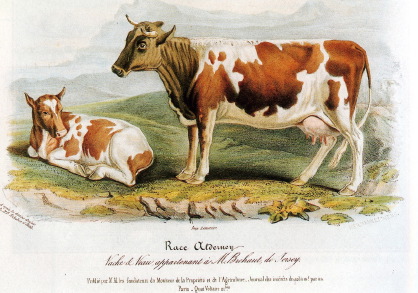 Alderney breed 1842 [Cow and calf, the property
of M. Brehaut of Jersey Colour Plate XIV. David Low. On The Domesticated
Animals Of The British Islands Comprehending The Natural And
Economical History Of Species And Varieties: The Description
Of The Properties Of External Form; And Observations On The Principles
And Practice Of Breeding. Pps 767. 1842.]
Alderney breed 1842 [Cow and calf, the property
of M. Brehaut of Jersey Colour Plate XIV. David Low. On The Domesticated
Animals Of The British Islands Comprehending The Natural And
Economical History Of Species And Varieties: The Description
Of The Properties Of External Form; And Observations On The Principles
And Practice Of Breeding. Pps 767. 1842.]
In 1815, Mr, Thomas Quale in his 'General view of the Agriculture
of the Norman Isles' states that up until the time 'No individual
has attempted, by the selection of cattle and breeding from them,
to attain any particular object'.
About this time, the end of the wars with France and the demise
of the 'privateering industry' led Guernseymen to look at new
ways of earning a living and in fact many people left the island
for new shores, especially America. A good trade had been built
up with England and the Guernseyman found that his cattle, now
famed for their rich milk were a useful source of income. However,
inferior French Cattle were still being imported into the islands
and some were exported by unscrupulous farmers as 'pure' Guernseys.
Accordingly statutes were enacted in both Jersey (1789) and Guernsey
(1819) forbidding the hither-to unrestricted importation of Cattle
from France but still allowing free trade in both directions
with England.
During the period from 1817, the date of the formation of La
Société d'Agriculture (the first Guernsey Agricultural
Society), -1877 it is known that cattle of other English breeds
were imported into Guernsey. Some were exhibited at the local
fatstock shows, two oxen of the Durham Breed being exhibited
at the 1862 Fat Cattle Show. The reappearance of black and white
as a recognised colour during this period also indicates the
possible reintroduction of Dutch type cattle. At the Guernsey
Society of Agriculture shows during the year 1820, 31 bulls were
seen and only one gained maximum points on the approved scale.
It was a Brindle, whose Dam gave the yellowest butter! There
was also a black and white bull in the prize list; the judges
recommended its use on black and white cows, it 'being of a good
breed'. In 1826, 8 animals described as Brindle or black were
on show and in 1827 the first prize heifer had a completely white
head.
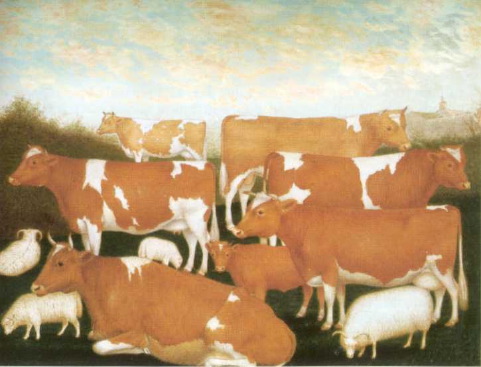
GUERNSEY CATTLE Circa 1850
It was not until 1877 that the door to importation from England
began to be closed due mainly to the need to protect the Island
from diseases such as Contagious Bovine Pleuropneumonia and Tuberculosis.
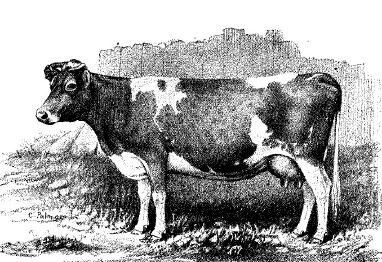 LILLIPUTIAN RGA&HS No 694 - line drawing
1884
LILLIPUTIAN RGA&HS No 694 - line drawing
1884
The R.G.A.&H.S. finally 'fixed' the colour of purebred
Guernseys on February 24th 1883 by adopting an article for the
judging scale indicating that this should be 'red or fawn and
white' and this has continued to be the accepted colour for the
past 120 years. The Golden Guernsey Breed had at last reached
an advanced stage of development.
The subsequent history of the breed is well documented in
Guernsey and other parts of the world through various Herd Book
registers, many of which trace back to the last quarter of the
nineteenth century. Prior to this period 'Guernseys' had of course
spread far afield but had never been kept 'pure bred' and became
mixed with other breeds. It was not until the agricultural improvement
societies sought to develop and maintain 'pure' bred Guernseys
(cattle that conformed to an accepted general type) firstly on
the Island, but very soon afterwards in America and England,
that the Guernsey Breed as we know it today was finally established.
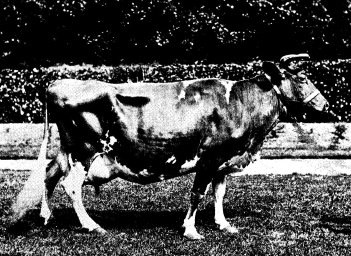
MAY ROSE II 3251 P.S.
The cow was then in her prime - a veritable queen and could
never be forgotten - Joseph L. Hope in 1891
BILL LUFF
GUERNSEY August 2004
References:
Prentice, E. Parmalee. 1942 American Dairy Cattle. Harper &
Brothers
Crump, Felicity. 1955. The Alderney Cow. Where did it come from?
What was it like? Where is it now? The Alderney Society, The
Museum Alderney C.1.
© This Document is copyright of Bill Luff and
the World Guernsey Cattle Federation
|

